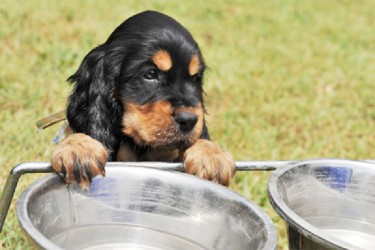(Continued from last week)
Weaning
The time to wean the pups away from the mother depends upon several factors which include the size of the litter. The condition of the dam, the availability of mother’s milk, and the inclinations of the breeder must be brought into the equation. Weaning usually can begin at three to six weeks of age and takes about one week to complete. The most important consideration, to my mind, is the health of the mother dog. Some dogs are such good mothers that they will suffer and try to accommodate the strain of continuous nursing –
Begin by offering one or two feedings a day of evaporated milk in equal parts of water, add baby cereal (oatmeal), and one raw egg yolk (for iron and protein). The end product should have the consistency of a sloppy gruel. Feed it in a low-rimmed metal dish (pie-pan).
Dip your fingers into the gruel and let your puppies lick it off – or dip their noses into it – until they get the message.
To stimulate the pups’ appetite, remove the mother an hour or two before feeding. After the meal, let her return to nurse.
Puppies who eat too much gruel are apt to get diarrhoea. This is due to a combination of overfeeding and perhaps some degree of intolerance to the evaporated milk. Accordingly, at least two feedings a day should still be by nursing.

Although many manufacturers recommend feeding dry or chunky puppy chow to weaning puppies, experience indicates that young puppies (three to six weeks of age) do not eat chunks. The commercial ration should be soaked well or, better yet, blended. When the puppy teeth get big and strong enough, puppies will begin to bite and swallow dry food.
Weaning now can proceed rapidly. Feed four times a day. Keep water available all the time. Puppies not getting enough water can come down with a kidney problem that may not appear until later in life. If it becomes necessary to dry the bitch up, a drop in her milk production is accomplished by reducing her food intake. Withhold all food and water the first day; the next day, feed her a quarter of the normal amount; the third day feed her one-half the normal amount. Restore her normal rations on the fifth day.
Allow me to share with you some amusing ‘asides’ relative to canines:
● A barking dog never bites. Well, at least not while it is barking
● A client of mine named his dog ‘Egypt’ because, as he (the client not the dog) explained, the dog left a pyramid (of faeces) in every room.
● Another client complained that his girlfriend kisses her dog on the lips, but refuses to drink from his glass.
Please implement disease preventative measures (vaccinations, routine dewormings, monthly anti-heartworm medication, etc) and adopt-a-pet from the GSPCA’s Animal Clinic and Shelter at Robb Street and Orange Walk, if you have the wherewithal to care well for the animals. Do not stray your unwanted pets, take them to the GSPCA’s Clinic and Shelter instead. If you do not wish your pet to have puppies or kittens, you may exploit the GSPCA’s free spay and neutering programme. If you see anyone being cruel to an animal, or if you need any technical information, please get in touch with the Clinic and Shelter by calling 226-4237.





